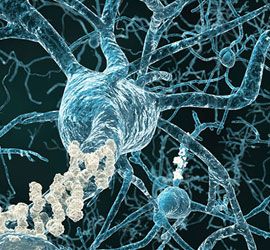Article
Brain Aging, Development, and Disease Explained
Author(s):
Identification of a brain circuit implicated in Alzheimer disease and schizophrenia could aid in comprehension of brain disorders and point to prevention strategies.
A brain circuit implicated in Alzheimer and schizophrenia is identified.

A neural network to explain how brain development relates to age-related brain decline and neurological disease has been proposed by a trans-European collaboration of researchers.
Gwenaëlle Douaud, PhD, at the Oxford University Functional MRI of the Brain Centre in the United Kingdom led the team of investigators from England, Germany, Norway, and Switzerland.
Many neuroscientists think that the regions of the brain that develop first are the ones that are lost last during the process of normal aging. However, direct evidence for this idea has up until now remained elusive. Investigators in the current study sought to examine the flipside of this idea, that brain regions that develop late may deteriorate first, and to further investigate whether these regions are involved in brain disorders.
The scientists examined structural brain images in 484 right-handed healthy patients aged 8 to 85 years (224 males and 260 females). Using MRI, they looked for regions that show changes with age and compared them with regions that are known to be abnormal in both schizophrenia and Alzheimer disease (AD). They conducted statistical analyses to identify regions that overlap.
The researchers identified a network of gray matter regions that organize late (during adolescence) in the course of normal brain development but also degenerate early in old age. The specific regions also are implicated in AD and schizophrenia.
In their paper, the authors noted, “This network of brain regions not only showed mirroring of healthy developmental and aging processes, but also demonstrated heightened vulnerability to etiologically distinct clinical disorders linked to abnormal adolescent and aging trajectories (schizophrenia and Alzheimer’s disease) and recapitulated the pattern of macrostructural abnormalities seen in both disorders.”
According to Dr Douaud, “Our results show that the same specific parts of the brain not only develop more slowly, but also degenerate faster than other parts. These complex regions, which combine information coming from various senses, seem to be more vulnerable than the rest of the brain to both schizophrenia and Alzheimer’s even though these two diseases have different origins and appear at very different, almost opposite, times of life.”
The study findings indicate that understanding processes of normal brain development could aid in the comprehension of brain disorders.
Dr Dounaud conveyed to Neurology Times that in addition to having implications for mechanisms of evolution, the study could point to possible prevention strategies, such as diet and exercise in AD. These strategies could perhaps be applied as early as adolescence and young adulthood for prevention of dementia. In addition, the overlapping brain networks imply that prevention strategies now tested in AD might one day also benefit persons who have or are at risk for schizophrenia.
The study was published in the November 24 issue of Proceedings of the National Academy of Sciences.1
Key points
• Scientists have identified gray matter regions that develop later in the human brain and deteriorate earlier.
• The identified brain circuit is implicated in normal aging but also in AD and schizophrenia.
• Understanding processes of normal brain development could aid in the comprehension of brain disorders.
References:
1. Dououd G, Groves AR, Tamnes CK, et al. A common brain network links development, aging, and vulnerability to disease. Proc Natl Acad Sci U S A. 2014 Nov 24. pii: 201410378. [Epub ahead of print.]




